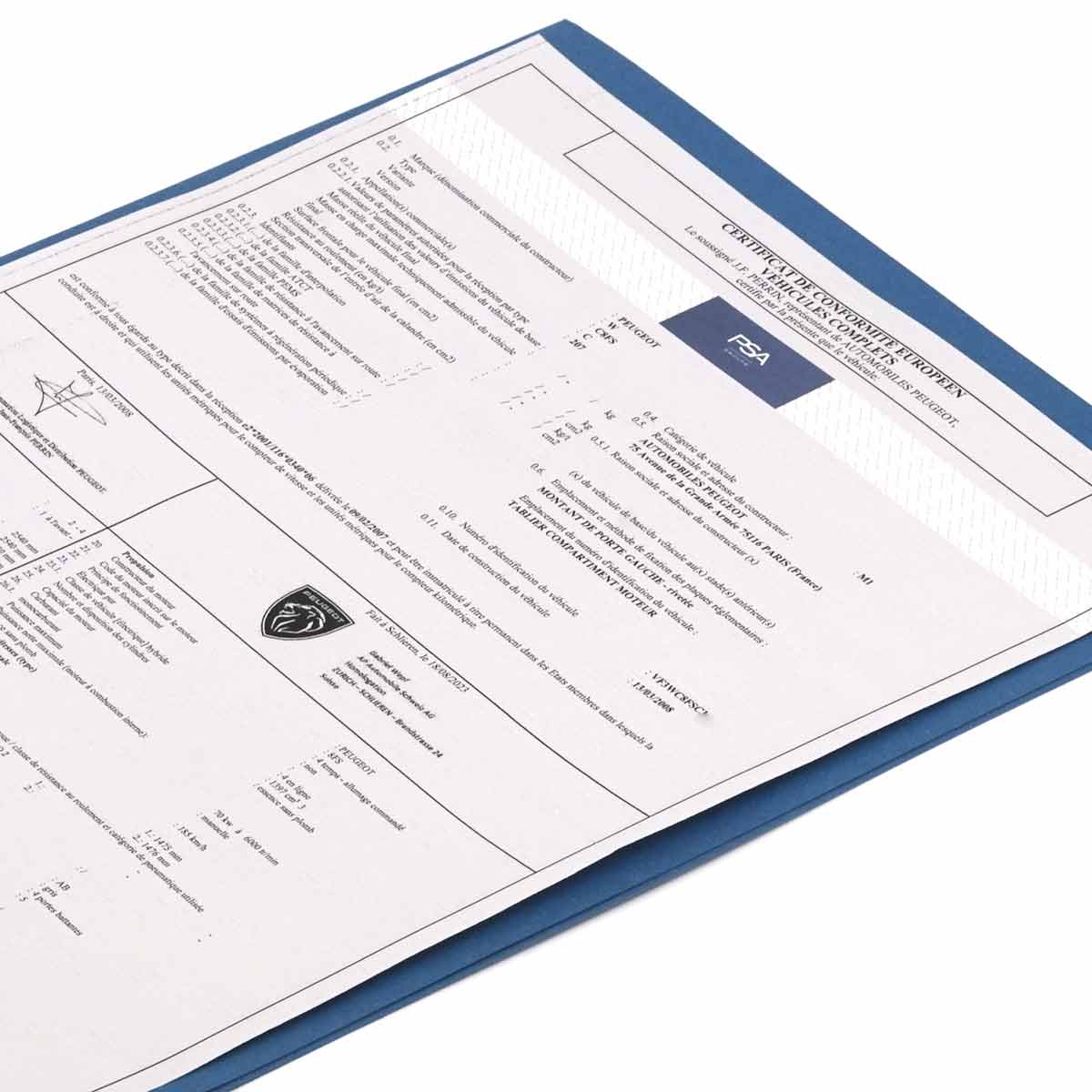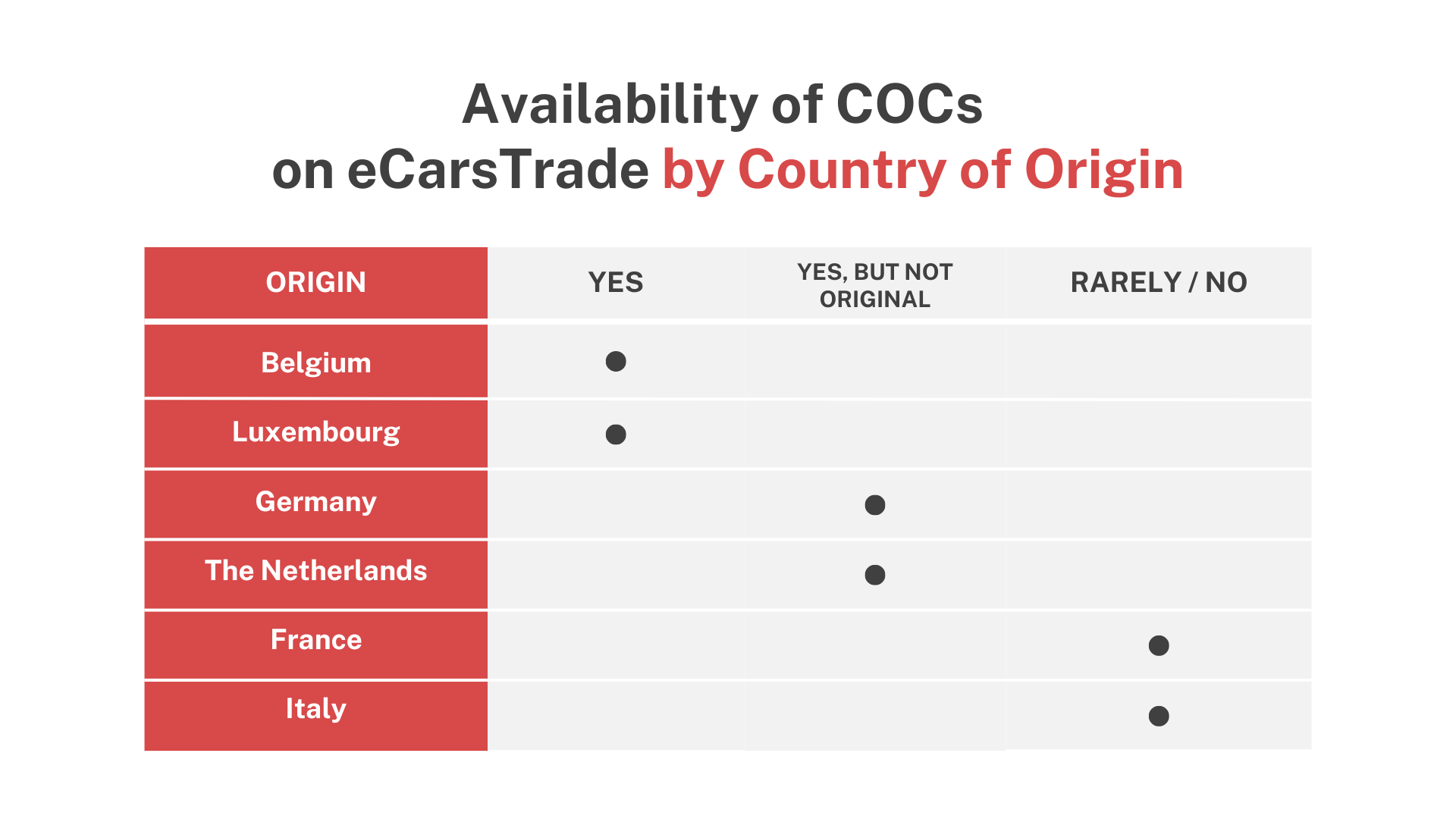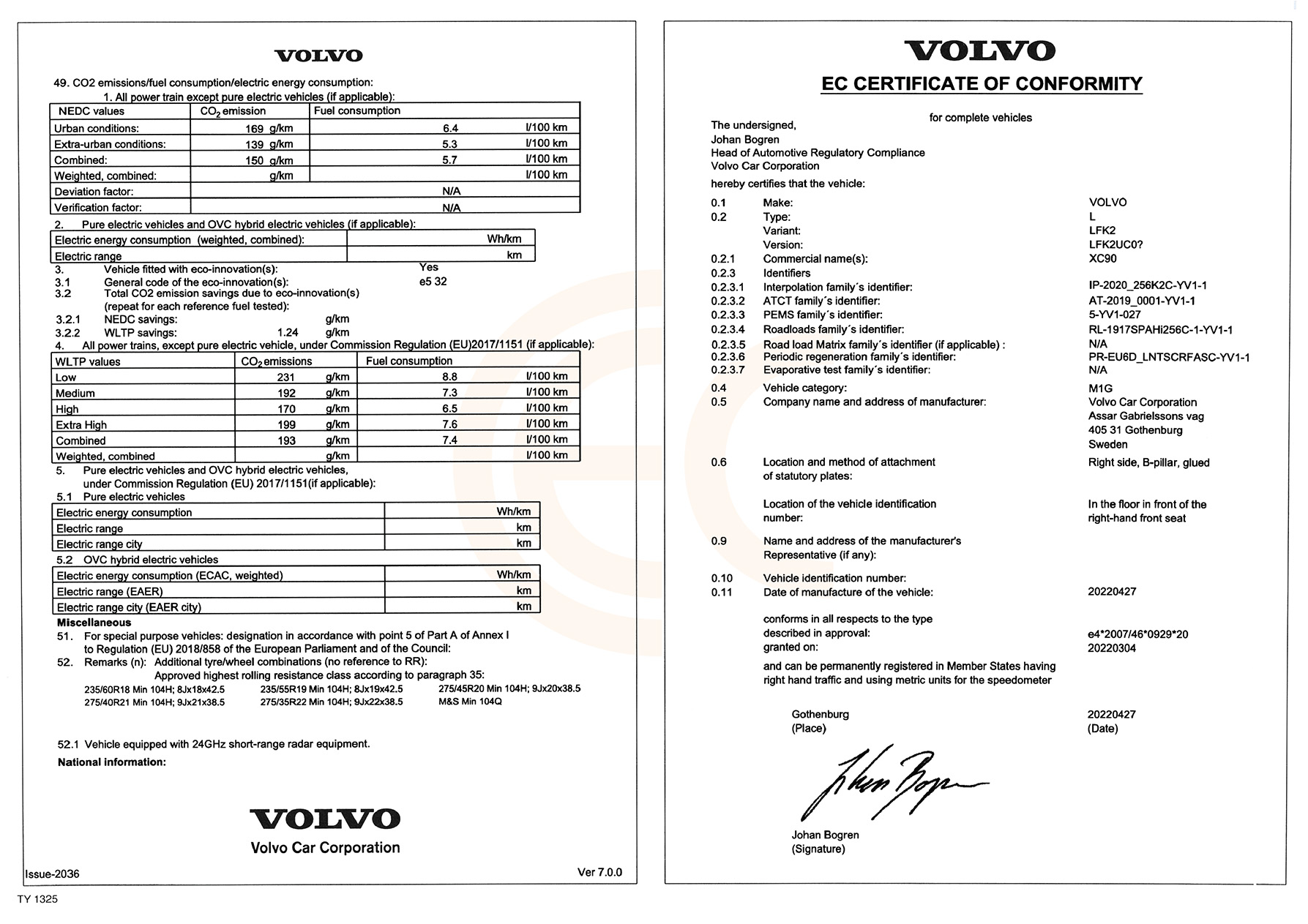- Blog
- What Is a COC (Certificate of Conformity) and How to Get It?
What Is a COC (Certificate of Conformity) and How to Get It?
Certificate of Conformity (COC) decoded: A must-read for car dealerships. Simplify compliance, streamline transactions, serve customers better.

Ključni podaci
- A Certificate of Conformity (COC) confirms a vehicle meets EU safety, environmental, and technical standards.
- COCs include key details like VIN, vehicle specifications, and compliance with emissions and safety standards, ensuring legal operation.
- For EU dealers, COCs are vital for legality, vehicle registration, customer trust, and smooth transactions.
- To get a COC, contact the manufacturer or use services like EUROCOC, provide VIN and documentation, and pay applicable fees.
- Critical for EU registration and cross-border trade; recognized in non-EU countries (Switzerland, Norway) for compliant vehicle imports
In the complex world of automotive regulations, a COC is a crucial document ensuring that vehicles meet the required standards and specifications set by authorities, like import regulations of cross-border trade.
For car dealerships, understanding everything about COCs is not just about compliance with these rules - it's essential for keeping your vehicle inventory in order and your customers happy.
What is a Certificate of Conformity?
A Certificate of Conformity (COC) is an official document provided by either a vehicle manufacturer or its authorized representative, proving that your vehicle is in compliance with EU regulations at the time of its production, covering aspects such as emissions, safety, and noise levels.
Another often-used option is a service like EUROCOC, streamlining the COC acquisition and ensuring the vehicles are registered with no hassle.
Offering your customers this certificate together with the purchase of a vehicle provides great customer service and increases their overall satisfaction.
The purpose of the document
The purpose of the Certificate of Conformity (COC) is to confirm that a vehicle adheres to the prescribed safety, environmental, and technical standards mandated by regulatory bodies.
It serves as proof that the vehicle meets the necessary specifications for lawful operation and registration within the European Union, and it may also be necessary for importing vehicles into specific countries beyond the EU.
The content of a COC - what should it include?
A typical Certificate of Conformity (COC) for a vehicle should include essential information such as:
1. Vehicle Identification Number (VIN)
2. Vehicle specifications (make, model, variant)
3. Confirmation of compliance with safety standards (e.g., crash test results)
4. Confirmation of compliance with environmental standards (e.g., emissions levels)
5. Confirmation of compliance with technical standards (e.g., engine specifications)
6. Manufacturer or authorized representative details
7. Issuance date
8. Regulatory references or approvals
9. Any additional information required by relevant authorities for registration or importation purposes.
Example:
Why does the COC matter for EU dealers?
The cross-border used car trade is very common for EU dealers. The COC is significant for EU dealerships for several reasons:
1. Legality: Within the European Union, vehicles must meet strict safety, environmental, and technical standards. The COC serves as evidence that the cars you’re selling comply with these regulations.
2. Vehicle registration: EU dealerships require COCs to streamline the vehicle registration process. Many EU countries mandate COCs as part of the registration documentation to confirm compliance with EU standards.
3. Customer care: Providing COCs to customers signifies that the dealership's vehicles meet regulatory standards, fostering trust in their safety, reliability, and legal compliance.
4. Quick buy: Ready access to COCs makes it easier to process vehicle transactions within the dealership, enabling smooth sales and registration processes for your end customers.
5. Compliance assurance: Dealerships must ensure the vehicles they sell align with EU regulations. Maintaining COCs reduces the risk of selling non-compliant vehicles.
How to get a COC?
Specific procedures and requirements for obtaining a COC may vary depending on the vehicle manufacturer, the vehicle's origin, and the destination country's regulations.
To obtain a Certificate of Conformity (COC) for a vehicle, follow these general steps:
- Contact the right authorities: Reach out to the manufacturer or their representative to request a COC for the specific vehicle. You can also use some of the popular online services like EUROCOC.
- Provide necessary information: You'll likely need to provide details such as the Vehicle Identification Number (VIN), and any other requested information, most likely vehicle make, model, and variant.
- Submit required documentation: Depending on the manufacturer's requirements and the vehicle's history, you may need to submit additional documentation, such as proof of ownership or purchase.
- Pay any applicable fees: Some manufacturers may charge a fee for issuing the COC.
- Receive the COC: Once the manufacturer or their representative verifies the vehicle's compliance, they will issue the COC. This document contains all the information confirming the vehicle's conformity to regulatory standards.
- Use the COC for registration or importation: With the COC, you can proceed with vehicle registration within the EU or import the vehicle into countries that recognize or require COCs for compliance purposes - like Portugal or Italy.
COC for new vehicles vs used vehicles
The process of obtaining a COC for new vehicles versus used vehicles generally involves similar steps, but there are some key differences:
1. Vehicle information
For new vehicles, you'll typically provide information such as the Vehicle Identification Number (VIN), model, and manufacturing date.
For used vehicles, in addition to the VIN and model, you may need to provide details about the vehicle's previous ownership history and registration status.

2. Documentation
When obtaining a COC for a new vehicle, you may need to submit documents such as the purchase agreement or sales invoice.
For a used vehicle, you may need to provide additional documentation to verify ownership and eligibility for the COC, such as proof of purchase, vehicle registration documents, or other relevant paperwork.
3. Fees
While both new and used vehicle COCs may have fees, the costs could vary. Manufacturers may charge different fees based on factors such as the vehicle's age, condition, and history.
4. Verification Process
The verification process for new vehicles typically focuses on confirming the vehicle's compliance with regulatory standards at the time of manufacture.
For used vehicles, the verification process may involve assessing the vehicle's compliance history, including any modifications or repairs made since its initial manufacture.

5. Applicability
New vehicle COCs are often required for registration and compliance purposes, particularly within the European Union.
Used vehicle COCs may also be necessary for registration or importation into certain countries, but the requirements and recognition of COCs for used vehicles can vary depending on the destination country's regulations.
Consult with the vehicle manufacturer or relevant authorities to understand the specific requirements and procedures for obtaining a COC, whether for a new or used vehicle. These may vary based on regional regulations and other factors.
Dealerships sometimes won’t be able to provide you with a COC. At eCarsTrade, whether the vehicle has a COC or not depends on where the vehicle comes from.
For example, most of our cars from Belgium and Luxembourg have a COC. Used vehicles from Germany and The Netherlands have a COC, but it’s not the original brand’s COC.
Second-hand cars from France and Italy will very rarely come with a COC.
FAQ
► Who issues the COC when buying a used vehicle?
When buying a used vehicle, the COC will typically already come with your used car as part of the car’s documentation. If the COC is not provided, you can request it directly from the brand of the car or buy it online from services like EUROCOC.
► Why is a COC important for vehicle registration in the EU?
The COC is crucial for vehicle registration within the EU because it confirms compliance with the regulatory standards established by the EU. It serves as evidence that the vehicle meets the necessary safety, environmental, and technical requirements for registration in EU member states.
If you don’t provide a COC during your import or registration procedure, you probably won’t be able to import/register the vehicle at all.
► What should dealers do if the COC is missing or lost?
If the COC is missing or lost, dealers should typically contact the vehicle manufacturer or its authorized representative to request a duplicate or replacement COC.
Also, dealers can inquire about the possibility of obtaining a COC from online services, relevant governmental authorities or agencies responsible for vehicle registration.
► Is the COC applicable to vehicles outside the EU?
The COC primarily applies to vehicles within the EU as it verifies compliance with EU regulatory standards. However, some countries outside the EU (e.g., Switzerland, Norway, Iceland, Liechtenstein) may also recognize and require COCs for imported vehicles. It depends on each country's specific regulations and requirements.
► Is a certificate of compliance the same document as a certificate of conformity?
No, a certificate of compliance (CoC) and a certificate of conformity (COC) are different documents, though they serve similar purposes in verifying regulatory compliance.
A COC, issued by the vehicle manufacturer or its representative, confirms a vehicle meets regulatory standards, essential for registration. Meanwhile, a CoC, a broader term, certifies compliance with specific standards or regulations across various industries.
Understanding the importance of COCs helps dealerships follow rules confidently, making customers trust them more.
Learning all about COCs will help you stay ahead in the fast-changing car industry and keep your business strong.




